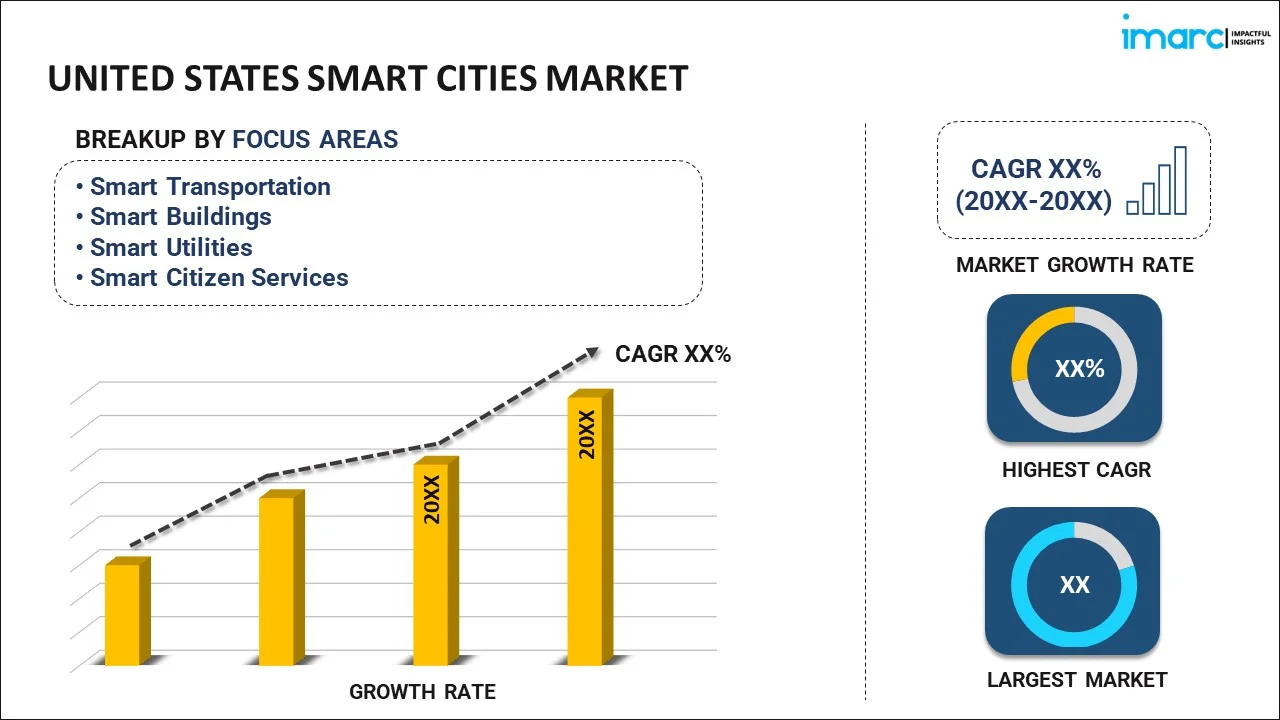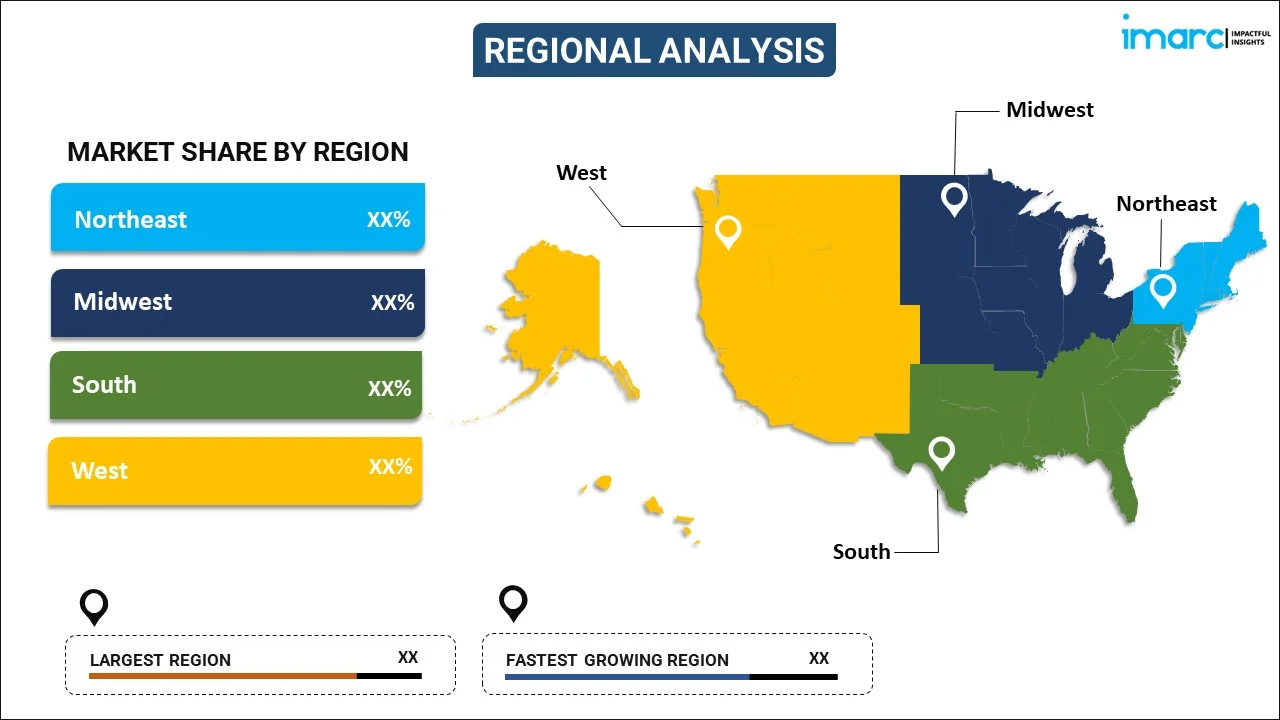
United States Smart Cities Market Report by Focus Area (Smart Transportation, Smart Buildings, Smart Utilities, Smart Citizen Services), Smart Transportation (Smart Ticketing, Traffic Management Systems, Passenger Information Management Systems, Freight Information Systems, Connected Vehicles, and Others), Smart Buildings (Building Energy Optimization, Emergency Management System, Parking Management System, and Others), Smart Utilities (Advanced Metering Infrastructure, Distribution Management System, Substation Automation, and Others), Smart Citizen Services (Smart Education, Smart Healthcare, Smart Public Safety, Smart Street Lighting, and Others), and Region 2025-2033
Market Overview:
The United States smart cities market size is projected to exhibit a growth rate (CAGR) of 12.10% during 2025-2033. The increasing urbanization and population, emerging technological advancements that improve the quality of life for individuals, and the implementation of favorable government initiatives offering financial support represent some of the key factors driving the market.
|
Report Attribute
|
Key Statistics
|
|---|---|
|
Base Year
|
2024
|
|
Forecast Years
|
2025-2033
|
|
Historical Years
|
2019-2024
|
| Market Growth Rate 2025-2033 | 12.10% |
Smart cities are urban environments that use advanced technologies and data-driven solutions to enhance the quality of life for residents, improve urban services, and foster sustainable development. It utilizes a network of interconnected devices, sensors, and data analytics to optimize various aspects of urban living, such as transportation, energy consumption, waste management, and public services. The foundation of a smart city lies in its ability to gather and analyze real-time data from various sources, including infrastructure, citizens, and the environment. It also allows city officials to make informed decisions that increase efficiency, reduce resource consumption, and improve citizen satisfaction. Additionally, smart cities include smart infrastructure such as intelligent transportation systems and energy-efficient buildings, digital connectivity, high-speed internet access to all citizens, and smart governance using data to make policy decisions and enhance public services. Additionally, citizen engagement and participation are essential in shaping the direction of smart city initiatives. It also offers several benefits, from optimized traffic flow and reduced energy consumption to improved emergency response times and public safety.
United States Smart Cities Market Trends:
The market is primarily driven by growing urbanization. In addition, the increasing population and the rising demand for smart city solutions to smart energy grids, waste management systems, and intelligent transportation networks that help cities manage resources and provide better services to their residents are influencing the market growth. Moreover, the emerging technological advances in the Internet of Things (IoT), data analytics, artificial intelligence (AI), and sensor technologies allow cities to gather, analyze, and interpret vast amounts of data representing another major growth-inducing factor. This data-driven approach empowers urban planners and decision-makers to optimize infrastructure, resource allocation, and public services. Besides this, the rising environmental concern led to the incorporation of energy-efficient infrastructure, renewable energy sources, and waste reduction strategies that reduce the environmental footprint of cities and lower operational costs in the long run, thus accelerating market growth. Along with this, the aging infrastructure requires significant maintenance and modernization, leading to the adoption of smart city technologies that allow for predictive maintenance, real-time monitoring of critical systems, and swift response to infrastructure issues resulting in cost savings, minimized disruptions, and improved quality of infrastructure services, thus propelling the market growth. Apart from this, the implementation of several favorable initiatives by federal, state, and local governments to support smart city projects through funding, regulatory measures, grants, and incentives that are often provided to encourage the adoption of innovative technologies that enhance urban living conditions, thus augmenting the market growth. Furthermore, the data collected from various sources, including sensors and social media, allows cities to make informed decisions and enables authorities to respond proactively to traffic congestion, pollution, and public health concerns, thus creating a positive market outlook.
United States Smart Cities Market Segmentation:
IMARC Group provides an analysis of the key trends in each segment of the United States smart cities market report, along with forecasts at the country level for 2025-2033. Our report has categorized the market based on focus area, smart transportation, smart buildings, smart utilities, and smart citizen services.
Focus Area Insights:

- Smart Transportation
- Smart Buildings
- Smart Utilities
- Smart Citizen Services
The report has provided a detailed breakup and analysis of the market based on the focus area. This includes smart transportation, smart buildings, smart utilities, and smart citizen services.
Smart Transportation Insights:
- Smart Ticketing
- Traffic Management System
- Passenger Information Management System
- Freight Information System
- Connected Vehicles
- Others
A detailed breakup and analysis of the market based on smart transportation has also been provided in the report. This includes smart ticketing, traffic management systems, passenger information management systems, freight information systems, connected vehicles, and others.
Smart Buildings Insights:
- Building Energy Optimization
- Emergency Management System
- Parking Management System
- Others
The report has provided a detailed breakup and analysis of the market based on the smart buildings. This includes building energy optimization, emergency management system, parking management system, and others.
Smart Utilities Insights:
- Advanced Metering Infrastructure
- Distribution Management System
- Substation Automation
- Others
The report has provided a detailed breakup and analysis of the market based on the smart utilities. This includes advanced metering infrastructure, distribution management system, substation automation, and others.
Smart Citizen Services Insights:
- Smart Education
- Smart Healthcare
- Smart Public Safety
- Smart Street Lighting
- Others
The report has provided a detailed breakup and analysis of the market based on the smart citizen services. This includes smart education, smart healthcare, smart public safety, smart street lighting, and others.
Regional Insights:

- Northeast
- Midwest
- South
- West
The report has also provided a comprehensive analysis of all the major regional markets, which include the Northeast, Midwest, South, and West.
Competitive Landscape:
The report has also provided a comprehensive analysis of the competitive landscape in the market. Competitive analysis such as market structure, key player positioning, top winning strategies, competitive dashboard, and company evaluation quadrant has been covered in the report. Also, detailed profiles of all major companies have been provided.
United States Smart Cities Market Report Coverage:
| Report Features | Details |
|---|---|
| Base Year of the Analysis | 2024 |
| Historical Period | 2019-2024 |
| Forecast Period | 2025-2033 |
| Units | Billion USD |
| Scope of the Report | Exploration of Historical and Forecast Trends, Industry Catalysts and Challenges, Segment-Wise Historical and Predictive Market Assessment:
|
| Focus Areas Covered | Smart Transportation, Smart Buildings, Smart Utilities, Smart Citizen Services |
| Smart Transportations Covered | Smart Ticketing, Traffic Management Systems, Passenger Information Management Systems, Freight Information Systems, Connected Vehicles, Others |
| Smart Buildings Covered | Building Energy Optimization, Emergency Management System, Parking Management System, Others |
| Smart Utilities Covered | Advanced Metering Infrastructure, Distribution Management System, Substation Automation, Others |
| Smart Citizen Services Covered | Smart Education, Smart Healthcare, Smart Public Safety, Smart Street Lighting, Others |
| Regions Covered | Northeast, Midwest, South, West |
| Customization Scope | 10% Free Customization |
| Post-Sale Analyst Support | 10-12 Weeks |
| Delivery Format | PDF and Excel through Email (We can also provide the editable version of the report in PPT/Word format on special request) |
Key Questions Answered in This Report:
- How has the United States smart cities market performed so far and how will it perform in the coming years?
- What has been the impact of COVID-19 on the United States smart cities market?
- What is the breakup of the United States smart cities market on the basis of focus area?
- What is the breakup of the United States smart cities market on the basis of smart transportations?
- What is the breakup of the United States smart cities market on the basis of smart buildings?
- What is the breakup of the United States smart cities market on the basis of smart utilities?
- What is the breakup of the United States smart cities market on the basis of smart citizen services?
- What are the various stages in the value chain of the United States smart cities market?
- What are the key driving factors and challenges in the United States smart cities market?
- What is the structure of the United States smart cities market and who are the key players?
- What is the degree of competition in the United States smart cities market?
Key Benefits for Stakeholders:
- IMARC’s report offers a comprehensive quantitative analysis of various market segments, historical and current market trends, market forecasts, and dynamics of the United States smart cities market from 2019-2033.
- The research study provides the latest information on the market drivers, challenges, and opportunities in the United States smart cities market.
- Porter's five forces analysis assist stakeholders in assessing the impact of new entrants, competitive rivalry, supplier power, buyer power, and the threat of substitution. It helps stakeholders to analyze the level of competition within the United States smart cities industry and its attractiveness.
- Competitive landscape allows stakeholders to understand their competitive environment and provides an insight into the current positions of key players in the market.
Need more help?
- Speak to our experienced analysts for insights on the current market scenarios.
- Include additional segments and countries to customize the report as per your requirement.
- Gain an unparalleled competitive advantage in your domain by understanding how to utilize the report and positively impacting your operations and revenue.
- For further assistance, please connect with our analysts.
 Inquire Before Buying
Inquire Before Buying
 Speak to an Analyst
Speak to an Analyst
 Request Brochure
Request Brochure
 Request Customization
Request Customization




.webp)




.webp)












